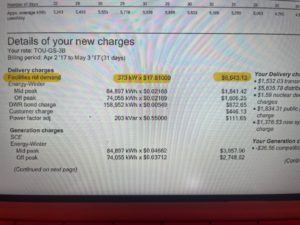Commercial demand charges for large businesses make up half of their electric utility bill! It is important for executives and business owners to know and understand commercial demand charges. Most people already know the general benefits that rooftop solar provides such as reducing electricity costs, boosting property values, and reducing carbon emissions. But did you know that solar and batteries can help lower peak demand charges?
- This SCE Commercial Customer Is Paying $7,000 A Month In Demand Charges!
In many states, peak power demand affects all commercial and business ratepayers. Peak demand occurs during times when generation, transmission, and distribution resources on the grid are being used at maximum capacity.
A commercial demand charge is an amount associated with the highest rate of electrical flow consumed in 15 minutes intervals at one time during a monthly billing period. Demand charges occur mostly when users consume large amounts of electricity in a shorter time period (examples can be starting up manufacturing equipment, HVAC systems, etc). These spikes can trigger high demand charges, whereas consistency in energy usage will temper the bill.
The reason that demand charges exist is that it is costly for utilities to always have power at the ready for customers at any given time. It is expensive to maintain equipment on constant standby. Utilities do not know for certain that peak demand will incur, but they must still be prepared for that scenario if and when it does. Also, the demand charge allows for an equitable billing process in that a customer who consumes more electricity at high speeds in shorter time periods during peak hours will be charged more for doing so.
When evaluating a large company’s electric bill, energy consumption is defined as the overall electricity usage, and demand is the peak intensity of that usage. Consumption is measured in kilowatt-hours (kWh), and demand is measured in kilowatts (kW). The calculation of a customer’s demand is based on taking the demand interval with the highest energy consumption and dividing it by the length of the demand interval in hours. A commercial customer’s electric bill will only show the peak demand for the month, so it is necessary for our commercial, industrial, and agricultural clients to provide us with one year’s 15- minute interval data in addition to their last year’s electric bills.
During the summertime months, energy consumption is at its peak, and utility companies struggle to keep up with the demand. Solar helps to offset some of that demand. In certain regions, solar has been found to help prevent power outages and rolling blackouts, thus strengthening the grid.
Solar can help reduce demand charges, but not completely eliminate them. Adding battery storage or an A.I. powered software solution like Extensible Energy’s DemandEx can drastically reduce peak demand, and demand charges. In fact, the ROI on these solutions is typically 3 years or less!
Contact Us!
Get your turnkey commercial, industrial, or agricultural solar system and battery proposal with ROI and financing options by e-mailing us your last 12 months electric bills, a picture of the facilities’ switchgear, and a picture of your roof today: info@beachcitiessolarconsulting.com


